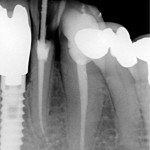
Effective obturation of the root canal is an important element of endodontic treatment. More than 50% of endodontic failures have been attributed to inadequate obturation. Cold lateral condensation (CLC) is one of the commonest methods of obturation while the Thermafil (TF) obturator was introduced in the late 1970s.
The aim of this study was to evaluate the outcome of root canal treatment (RoCT) using either TF or CLC as the obturation technique in asymptomatic teeth with periapical lesions and to investigate the impact of potential prognostic factors on postoperative pain and treatment outcomes during a 2-year follow-up.
Methods
Patients with mature maxillary anterior teeth with periapical lesions (<5 mm) requiring RoCT were randomly allocated to the TF or CLC technique. Standardised RoCT was carried out over 2 visits under local anaesthesia and rubber dam. The patient’s age and sex, obturation time, postoperative pain, and obturation length were recorded. The quality of the root canal fillings and the status of the periapical tissues were evaluated according to the periapical index (PAI). Obturation length was classified as ‘short’ (>2 mm from the radiographic apex), ‘acceptable’ (0–2 mm from the radiographic apex), or ‘overfilled’ (beyond the radiographic apex). Postoperative pain was measured using a visual analog scale. Patient’s were followed up every 3 months for 1 year and then at 6-month intervals for 2 years. Based on the clinical and radiographic features, teeth, scoring PAI 1 and PAI 2 were classified as healed. Those with PAI score 3 or with any clinical signs and symptoms were considered ‘diseased’.
Results
- 120 teeth were initially included in the study;
- 112 teeth from 92 patients were available at 2 years recall.
- 8 patients dropped out.
- The patient’s age ranged from 18–65 years. Mean age was 29.55 years in the TF group and 30.36 years in the LC group)
- Obturation time in the LC group was 7.582 ± 1.274 mins and 0.673 ± 0.112 mins in the TF group. This difference was statistically significant (P < .001).
- 19 (34%) teeth filled with TF and 7 (12%) filled with CLC were overfilled.
- There were no significant differences between both techniques in the incidence of postoperative pain at 24 hours (P > .05), but the incidence of pain at 48 hours in the TF treatment group was significantly higher than in the CLC treatment group (P < .05)
- At the 2-year follow-up, the overall success rate was 97.3%.
- There was a slightly higher number of healed cases in the CLC group (55/56 teeth, 98.2%) that the
- TF group (54/56 teeth, 96.4%) but this was not statistically significant.
Conclusions
The authors concluded
The clinical and radiographic success rates of the TF obturation technique are comparable with those of the LC obturation technique in RCT of permanent teeth with periapical lesions.
Comments
A 2007 systematic review by Peng et al examined the differences in clinical outcomes between root canal obturation by warm gutta-percha or cold lateral condensation. That review included 10 clinical studies involving a total of 1748 teeth. That review found no difference between the two obturation techniques for any outcome other than over extension. As in this current study more over extension was seen with the warm gutta-percha technique. In the Peng review a majority of the included studies were considered to be of low quality, and they called for further studies to be conducted following the CONSORT guidelines for reporting.
This current study while a randomised trial does not provide a CONSORT flow diagram or report on some of the relevant criteria. With radiographic outcomes were assessed by observers blind to the treatment provided there is no indication of whether clinical outcome assessor was also blind to the outcomes. Randomisation was carried out using sealed envelopes, which were shuffled so there is potential for some manipulation of the sequence. Overall the study is of reasonable quality and it lends some support to the findings of the earlier systematic review. Although additional high quality clinical studies was be helpful to compare a range of obturation techniques
Links
Primary paper
Kandemir Demirci G, Çalışkan MK. A Prospective Randomized Comparative Study of Cold Lateral Condensation Versus Core/Gutta-percha in Teeth with Periapical Lesions. J Endod. 2016 Feb;42(2):206-10. doi: 10.1016/j.joen.2015.10.022. Epub 2015 Dec 11. PubMed PMID: 26686053.
Other references
Peng L, Ye L, Tan H, Zhou X. Outcome of root canal obturation by warm gutta-percha versus cold lateral condensation: a meta-analysis. J Endod. 2007 Feb;33(2):106-9. Epub 2006 Dec 22. Review. PubMed PMID: 17258624.

Similar outcomes from hot or cold root canal obturation finds trial https://t.co/xzDrfJ5ZXW
[…] 0 0 0 http://www.nationalelfservice.net/dentistry/endodontics/root-canal-obturation-hot-cold/ […]
Root canal obturation – hot or cold? https://t.co/xzDrfJ5ZXW
Hot or cold root canal obturation have similar outcomes https://t.co/xzDrfJnBmw
Cold lateral condensation Vs core/gutta-percha for root canal obturation https://t.co/xzDrfJnBmw
Trail finds that hot or cold root canal obturation had similar outcomes https://t.co/xzDrfJnBmw
Don’t miss – Root canal obturation-hot or cold? https://t.co/xzDrfJnBmw
[…] Root canal obturation-hot or cold? […]